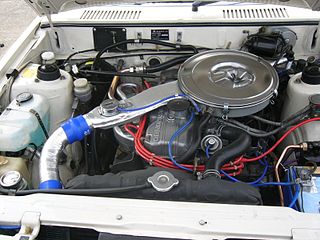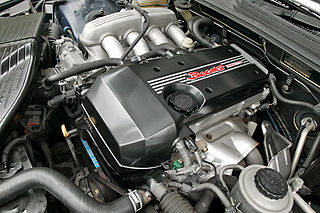Related Research Articles

The GE Genesis is a series of passenger diesel locomotives built by GE Transportation for Amtrak, Metro-North, and Via Rail between 1992 and 2001. A total of 321 units were produced.

The Toyota A Series engines are a family of inline-four internal combustion engines with displacement from 1.3 L to 1.8 L produced by Toyota Motor Corporation. The series has cast iron engine blocks and aluminum cylinder heads. To make the engine as short as possible, the cylinders are siamesed.

Power Stroke, also known as Powerstroke, is the name used by a family of diesel engines for trucks produced by Ford Motor Company and Navistar International for Ford products since 1994. Along with its use in the Ford F-Series, applications include the Ford E-Series, Ford Excursion, and Ford LCF commercial truck. The name was also used for a diesel engine used in South American production of the Ford Ranger.

Toyota Motor Corporation's M family of engines were a longitudinally mounted straight-6 engine design. They were used from the 1960s through the 1990s. All M family engines were OHC designs. While the M family was born with a chain-driven single camshaft it evolved into a belt-driven DOHC system after 1980. All M family engines used a cast-iron block with an aluminum cylinder head, and were built at the Toyota Kamigo plant in Toyota City, Japan.

The General Electric LM6000 is a turboshaft aeroderivative gas turbine engine. The LM6000 is derived from the CF6-80C2 aircraft turbofan. It has additions and modifications designed to make it more suitable for marine propulsion, industrial power generation, and marine power generation use. These include an expanded turbine section to convert thrust into shaft power, supports and struts for mounting on a steel or concrete deck, and reworked controls packages for power generation. It has found wide use including peaking power plants, fast ferries and high speed cargo ship applications.

The Mitsubishi Astron or 4G5/4D5 engine, is a series of straight-four internal combustion engines first built by Mitsubishi Motors in 1972. Engine displacement ranged from 1.8 to 2.6 litres, making it one of the largest four-cylinder engines of its time.

The Toyota JZ engine family is a series of inline-6 automobile engines produced by Toyota. As a replacement for the M-series inline-6 engines, the JZ engines were 24-valve DOHC engines in 2.5- and 3.0-litre versions.

The Honda A series inline-four cylinder engine is used in 1980s Honda Accord and Prelude models. It was introduced in 1982, with the second-generation Honda Prelude, and available in three displacement sizes: 1.6-, 1.8- and 2.0-liters. It features cast iron block and aluminum SOHC head design with three valves per cylinder for a total of 12 valves. It was available in carbureted and fuel-injected configurations

The Toyota Mark II is a compact, later mid-size sedan manufactured and marketed in Japan by Toyota between 1968 and 2004. Prior to 1972, the model was marketed as the Toyota Corona Mark II. In most export markets, Toyota marketed the vehicle as the Toyota Cressida between 1976 and 1992 across four generations. Toyota replaced the rear-wheel-drive Cressida in North America with the front-wheel-drive Avalon. Every Mark II and Cressida was manufactured at the Motomachi plant at Toyota, Aichi, Japan from September 1968 to October 1993, and later at Toyota Motor Kyushu's Miyata plant from December 1992 to October 2000, with some models also assembled in Jakarta, Indonesia and Parañaque, Philippines as the Cressida.

The Nissan Z engine is a series of automobile and light truck four-cylinder engines that was engineered by Nissan Machinery, manufactured by the Nissan Motor Company from 1979 through August 1989. All Z engines had 4 cylinders, a total of 8 valves and a single overhead camshaft (SOHC). Displacements ranged from 1.6 L to 2.4 L.The Z series' engine blocks were nearly identical to those of the earlier L Series with the exception of the Z24. While the Z16 and Z18 engines had a deck height similar to the earlier L13/L14/L16/L18 variants, the Z24 had a taller deck height to accommodate a longer stroke. The most notable difference between the Z-series engine and its predecessor was the introduction of a new crossflow cylinder head which reduced emissions by moving the intake ports to the right side of the engine opposite the exhaust ports. This change allows the exhaust port velocity to more effectively scavenge the cylinder and reduce reversion pulses to enhance induction. This change also limits maximum valve lift/lobe lift profiles rendering the cylinder head and valve train configuration undesirable for high-performance uses. The Z series evolved into the NA and KA engines which, along with the smaller CA series, replaced the Z series.

Wärtsilä Oyj Abp, trading internationally as Wärtsilä Corporation, is a Finnish company which manufactures and services power sources and other equipment in the marine and energy markets. The core products of Wärtsilä include technologies for the energy sector, including gas, multi-fuel, liquid fuel and biofuel power plants and energy storage systems; and technologies for the marine sector, including cruise ships, ferries, fishing vessels, merchant ships, navy ships, special vessels, tugs, yachts and offshore vessels. Ship design capabilities include ferries, tugs, and vessels for the fishing, merchant, offshore and special segments. Services offerings include online services, underwater services, turbocharger services, and also services for the marine, energy, and oil and gas markets. At the end of December 2023, the company employed 17,800 workers.

The Toyota S Series engines are a family of straight-four petrol engines with displacements between 1.8 and 2.2 litres, produced by Toyota Motor Corporation from January 1980 to August 2007. The S series has cast iron engine blocks and aluminium cylinder heads. This engine was designed around the new LASRE technology for lighter weight – such as sintered hollow camshafts.
A camless or free-valve piston engine is an engine that has poppet valves operated by means of electromagnetic, hydraulic, or pneumatic actuators instead of conventional cams. Actuators can be used to both open and close valves, or to open valves closed by springs or other means.

The Subaru EJ engine is a series of four-stroke automotive engines manufactured by Subaru. They were introduced in 1989, intended to succeed the previous Subaru EA engine. The EJ series was the mainstay of Subaru's engine line, with all engines of this series being 16-valve horizontal flat-fours, with configurations available for single, or double-overhead camshaft arrangements. Naturally aspirated and turbocharged versions are available, ranging from 96 to 310 hp. These engines are commonly used in light aircraft, kit cars and engine swaps into air-cooled Volkswagens, and are also popular as a swap into Volkswagen T3/Vanagons powered by the Volkswagen Wasserboxer engine. Primary engineering on the EJ series was done by Masayuki Kodama, Takemasa Yamada and Shuji Sawafuji of Fuji Heavy Industries, Subaru's parent company.

The EMD 710 is a line of diesel engines built by Electro-Motive Diesel. The 710 series replaced the earlier EMD 645 series when the 645F series proved to be unreliable in the early 1980s 50-series locomotives which featured a maximum engine speed of 950 rpm. The EMD 710 is a relatively large medium-speed two-stroke diesel engine that has 710 cubic inches displacement per cylinder, and a maximum engine speed of 900 rpm.
The SD engine was replaced by the Nissan TD engine. It was manufactured by Minsei Diesel Industries, Ltd., which was renamed Nissan Diesel Motor Co., Ltd in 1960.

The Yanmar 2GM20 is a series of inboard marine diesel engines manufactured by the Japanese company Yanmar Co. Ltd. It is used in a wide range of sailboats and motorboats. The 2GM20 is out of production and has been superseded by the newer Yanmar 3YM20 series.
Emission control areas (ECAs), or sulfur emission control areas (SECAs), are sea areas in which stricter controls were established to minimize airborne emissions from ships as defined by Annex VI of the 1997 MARPOL Protocol.
The EMD 1010 or EMD 265 is a line of four-stroke diesel engines manufactured by Electro-Motive Diesel. The precursor to the 1010 was introduced around 1998 as the 265H or H-Engine. The H-engine was initially designed for use as a 6,300 hp (4,700 kW) 16 cylinder, the EMD SD90MAC; however, the early engines were found to be unreliable, and unsuccessful in the market, with the proven EMD 710 2-stroke design being preferred. The EMD four-stroke engine was resurrected in 2015 to meet EPA Tier 4 emissions regulations.